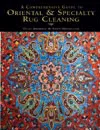Oriental Rugs and Disaster Restoration Part II

In March we discussed how rugs impacted by a disaster can often be salvaged. This type of restoration requires careful pre-qualification with all parties due to the many variables in the disaster loss, rug dyes, construction, etc.
Last time we focused on fire damage; today we will look at rugs that are part of a water loss. Due to the potential value of some semi-antique or antique rugs, you may be asked to perform heroic action. This is salvage cleaning and the results will not be known until after completion of your efforts. A good relationship with the insurance company is critical, as time and materials can be spent without satisfactory results achieved for the insured.
As stated in the “IICRC S500 Standard and Reference Guide for Professional Water Damage Restoration,” a home furnishing item must be returned to the client in a sanitary condition; if not, disposal is recommended. To confirm a sanitary condition, the services of an industrial hygienist will be necessary.
Due to the nature of contaminates found in a water loss, use an EPA-registered product to clean and sanitize rugs. Also, look for products that have WoolSafe approval so you know they have been tested as safe to use on wool rugs.
The following steps can be used for cleaning and restoration of rugs exposed to sewage intrusion.
- Preliminary decontamination – Remove microbial contaminants by flushing the rug with clear water.
- Squeegee, wring or extract to remove majority of the water.
- Flush rug again with clear water.
- Squeegee, wring or extract to remove majority of water.
- Immerse rug in water with a solution of a registered sanitizer (mixed at the manufacturer’s recommended dilution ratio). Allow solution to remain in contact with the rug for at least 30 minutes (or per manufacturer’s directions).
- Squeegee, wring, or extract to remove majority of cleaner/sanitizing solution.
- Clean rug then flush rug with clear water.
- Squeegee, wring, or extract to remove majority of water.
- Dry the rug in dry room, or flat with air movers if there is a chance of dye bleeding.
- Confirmation test can be performed to determine sanitization efficacy.

- Preliminary decontamination prior to transporting – remove microbial contaminates by HEPA vacuuming with an upright vacuum in multiple directions. Workers should wear P-100 respirator, nitrite gloves, long pants and long sleeve shirts.
- Cut an oversized piece of 6-10 ml plastic film to allow rug to be wrapped and effectively sealed. Roll rug in plastic film and tape all seams with duct tape.
- In an enclosed area with an exhaust ventilated to the outdoors or in an enclosed area in which HEPA-filtered air scrubbers provide 4-6 air changes per hour, workers wearing appropriate PPE (personal protective equipment) unwrap the rug. HEPA vacuum first, then put the rug through a dusting machine or air-wash using high-pressure compressed air.
- Prepare a solution of an EPA-registered carpet sanitizer and dampen surface of the rug per the manufacturer’s directions.
- Shampoo rug with a solution of an EPA-registered sanitizing product and a WoolSafe shampoo. Ensure rug is thoroughly saturated with the solution. Allow sanitizing solution to remain in contact with rug for at least 30 minutes.
- Flush rug with clear water.
- Squeegee, wring or extract to remove majority of water.
- Wash rug, squeegee, wring or extract water.
- Dry rug in a dry room or in sun if rug will tolerate direct sun light.
- Confirmation testing can be performed to determine sanitization efficacy.
Keeping track of rugs in a restoration company is no different than tracking them through a rug cleaning operation. Every company has a different procedure, but there are common elements:
- The rug is identified and measured. If your employees cannot identify rugs by name, then they should describe the rug in terms of color, design and size. Do not include the fringe when measuring, and note the size in feet and inches (or centimeters).
- Inspect the rug for damage and stains.
- Write the above information on a work order.
- Tag the rug with a tear proof and waterproof tag such as Tyvek that includes the following information:
- Customer name
- Size and piece number (2 of 3, 3 of 5, etc)
- Invoice number
- Special instructions for the plant crew
- Office will input the written information into their computer system no latter than the following morning.
It is the author’s opinion that in-plant total immersion is the most thorough method of cleaning rugs. Severe damage to rugs will require invasive cleaning methods. Many disaster restoration companies do not have a specialized rug-cleaning department. I recommend these restoration companies sub-contract their cleaning out to those who are active in the rug-cleaning business.
Looking for a reprint of this article?
From high-res PDFs to custom plaques, order your copy today!





